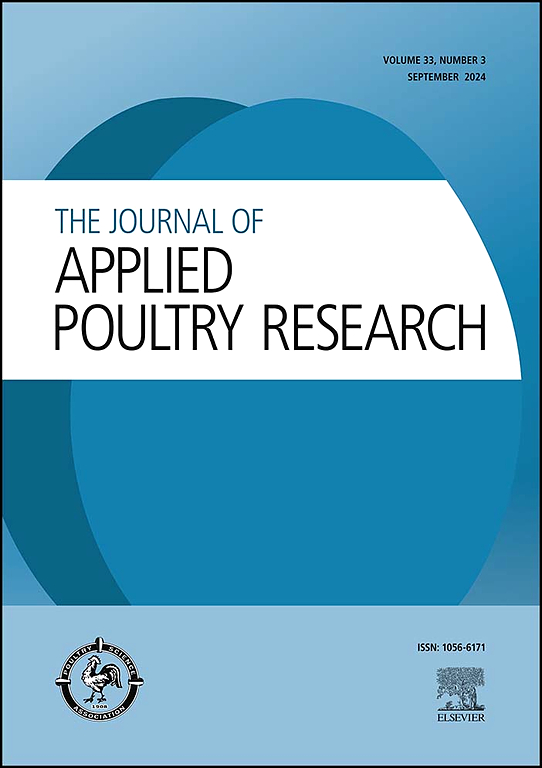Effect of a Bacillus-based probiotic on fecal shedding and cecal colonization of Salmonella Enteritidis in laying hens
IF 2
3区 农林科学
Q2 AGRICULTURE, DAIRY & ANIMAL SCIENCE
引用次数: 0
Abstract
This study was conducted to evaluate a Bacillus-based probiotic to reduce Salmonella Enteritidis (SE) infection in Hy-Line W-36 hens at 24 weeks of age. The hens were assigned to four treatment groups: non challenged with basal diet (NC); challenged with basal diet (PC), PC + probiotic at 1 × 106 CFU/kg (PRO1), and PC + probiotic at 2 × 106 CFU /kg (PRO2). The probiotic used was a combination of five strains of Bacillus spp. Birds were adapted to the experimental diets for one week after which challenged birds were orally gavaged for two consecutive days with approximately 1 × 109 colony-forming units (CFU) of nalidixic acid-resistant SE. Feed and water were provided ad libitum throughout the experiment. Fecal samples were collected on 3-, 7- and 14-days post inoculation (dpi). Cecal contents were collected aseptically on 7 and 14 dpi. Both fecal and cecal samples were plated on xylose lysine tergitol 4 (XLT4) plates with 200 ppm nalidixic acid using the direct plate method. Fecal samples were further enriched as per the National Poultry Improvement Plan procedures on tetrathionate (TT) and Rappaport Vassiliadis (RV) broth. Data were log-transformed and analyzed using the PROC GLIMMIX procedure of SAS 9.4. In the Ceca, PRO1 reduced the concentration of SE by 0.90 logs at 7 dpi (P=0.046). Although at 14 dpi both PRO1 and PRO2 decreased SE by 0.40 and 0.60 logs in the ceca (P=0.08). Similarly at 14 dpi, PRO1 and PRO2 reduced SE concentration by 0.80 and 0.75 logs in fecal samples using direct plating (P=0.032). Similarly, we observed that RV and TT enrichment increased SE counts by 1.5 and 2.6 logs, respectively at 14 dpi (P<0.001). This indicates that the enrichment method increased the SE enumeration as compared to direct plating method. There were no differences in SE fecal shedding at 0, 3, and 7 dpi by direct platting or enrichment methods. In conclusion, Bacillus-based probiotics have the potential to reduce SE in both ceca and fecal samples from laying hens.
一种芽孢杆菌益生菌对蛋鸡肠炎沙门氏菌排便及盲肠定殖的影响
本试验旨在研究一种以芽孢杆菌为基础的益生菌对24周龄Hy-Line W-36蛋鸡肠炎沙门氏菌感染的影响。母鸡分为4个处理组:基础饲粮(NC)未攻饲;分别饲喂基础饲粮(PC)、PC +益生菌(1 × 106 CFU/kg, PRO1)和PC +益生菌(2 × 106 CFU/kg, PRO2)。采用5株芽孢杆菌组合的益生菌,对试验饲粮适应1周后,连续2天灌胃抗萘啶酸SE菌落形成单位(CFU)约1 × 109。在整个试验过程中,饲料和水的供应是随意的。分别于接种后3、7、14天采集粪便样本。在7和14 dpi时无菌收集盲肠内容物。将粪便和盲肠样品用200 ppm纳啶酸直接平板法镀在木糖赖氨酸tergitol 4 (XLT4)板上。按照国家家禽改良计划程序,对四硫酸盐(TT)和拉帕波特(RV)肉汤进一步富集粪便样本。使用SAS 9.4的PROC GLIMMIX程序对数据进行日志转换和分析。在Ceca中,PRO1在7 dpi时使SE浓度降低0.90 log (P=0.046)。虽然在14 dpi时,PRO1和PRO2在盲肠内降低了0.40和0.60 log (P=0.08)。同样,在14 dpi时,PRO1和PRO2在直接电镀的粪便样品中降低了0.80和0.75 log的SE浓度(P=0.032)。同样,我们观察到RV和TT富集在14 dpi时分别使SE计数增加1.5和2.6 log (P<0.001)。这表明富集法比直接镀法增加了SE计数。在0、3和7 dpi时,通过直接镀或富集方法,SE粪便排出量没有差异。由此可见,以芽孢杆菌为基础的益生菌具有降低蛋鸡盲肠和粪便中硒含量的潜力。
本文章由计算机程序翻译,如有差异,请以英文原文为准。
求助全文
约1分钟内获得全文
求助全文
来源期刊

Journal of Applied Poultry Research
农林科学-奶制品与动物科学
CiteScore
4.10
自引率
10.50%
发文量
80
审稿时长
104 days
期刊介绍:
The Journal of Applied Poultry Research (JAPR) publishes original research reports, field reports, and reviews on breeding, hatching, health and disease, layer management, meat bird processing and products, meat bird management, microbiology, food safety, nutrition, environment, sanitation, welfare, and economics. As of January 2020, JAPR will become an Open Access journal with no subscription charges, meaning authors who publish here can make their research immediately, permanently, and freely accessible worldwide while retaining copyright to their work. Papers submitted for publication after October 1, 2019 will be published as Open Access papers.
The readers of JAPR are in education, extension, industry, and government, including research, teaching, administration, veterinary medicine, management, production, quality assurance, product development, and technical services. Nutritionists, breeder flock supervisors, production managers, microbiologists, laboratory personnel, food safety and sanitation managers, poultry processing managers, feed manufacturers, and egg producers use JAPR to keep up with current applied poultry research.
 求助内容:
求助内容: 应助结果提醒方式:
应助结果提醒方式:


